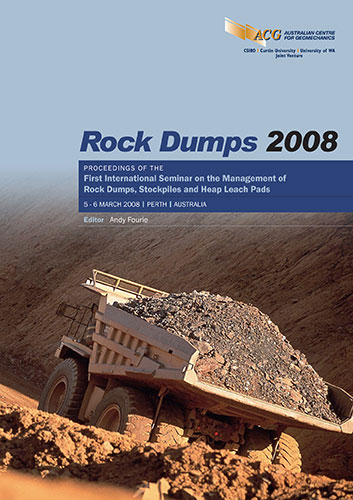Rainfall Infiltration Into and Seepage From Rock Dumps — A Review

|
Authors: Williams, DJ; Rohde, TK |
DOI https://doi.org/10.36487/ACG_repo/802_7
Cite As:
Williams, DJ & Rohde, TK 2008, 'Rainfall Infiltration Into and Seepage From Rock Dumps — A Review', in AB Fourie (ed.), Rock Dumps 2008: Proceedings of the First International Seminar on the Management of Rock Dumps, Stockpiles and Heap Leach Pads, Australian Centre for Geomechanics, Perth, pp. 79-89, https://doi.org/10.36487/ACG_repo/802_7
Abstract:
Mine rock typically emerges from an open pit relatively dry, and is conventionally stored in surface dumps where it progressively becomes wet-up by rainfall infiltration over time. Slow infiltration into the rock dump following light rainfall is likely to be largely restricted to the traffic-compacted surficial layer of the dump from which much of it is likely to be evaporated. Rapid infiltration into the rock dump following prolonged heavy rainfall is likely to be dominated by flow along distinct preferred seepage pathways, leading to deep drainage and the emergence of some of this as seepage from the base of the dump. Rainfall infiltration into a bare, loosely-dumped rock dump is commonly assumed to be 30 to 60% of average annual rainfall, depending on the climate, and the physical and chemical characteristics of the rock. However, there is a lack of field data to confirm this. A 15 m high trial rock dump covering 0.71 ha was constructed at a mine in New South Wales, Australia. It was instrumented with two lysimeters at the surface of the dump and 24 lysimeters at the base of the dump to monitor infiltration through the top and base seepage beneath the top surface and the side slopes of the dump. The paper presents the results of 16 months of monitoring of the trial rock dump lysimeters. They show that total infiltration into the top of the trial dump was about 50% of the total 16- months of well below average rainfall, with the majority of the infiltration going into storage within the dump and only a minor amount reaching the base of the dump via preferred seepage pathways. Runoff from the top of the trial dump is not allowed so that the remaining 50% of the total rainfall was lost to evaporation from surface ponding. The trigger rainfall required for base seepage was found to reduce exponentially from about 30 mm initially to 2.5 mm, and the response time from about 10 days to 2.5 days as the dump wets-up. A review of the literature and other sources is also presented that provides available data worldwide on rainfall infiltration into and seepage from rock dumps located in a range of climates.
References:
Adu-Wusu, C. and Yanful, E.K. (2006) Performance of engineered test covers on acid-generating waste rock at Whistle
Mine, Ontario. Canadian Geotechnical Journal, 43, pp. 1-18.
Adu-Wusu, C. and Yanful, E.K. (2007) Post-closure investigation of engineered test covers on acid-generating waste
rock at Whistle Mine, Ontario. Canadian Geotechnical Journal, 44, pp. 496-506.
Bews, B.E., O'Kane, M.A., Wilson, G.W., Williams, D.J. and N. Currey, N.A. (1997) The design of a low flux cover
system, including lysimeters for acid generating waste in semi-arid environments, Proceedings of the Fourth
International Conference on Acid Rock Drainage, Vancouver, 31 May-6 June 1997, pp. 747-762.
Carey, S.K., Barbour, S.L. and Hendry, M.J. (2005) Evaporation from a waste rock surface, Key Lake, Saskatchewan.
Canadian Geotechnical Journal, 42, pp. 1189-1199.
Cedergren, H. (1977) Seepage, Drainage, and Flow nets. John Wiley & Sons, New York.
Herasymuik, G.M., Wilson, G.W., Barbour, S.L. and Smith, T. (1995) The characterization of hydrologic properties and
moisture migration pathways of a waste rock dump. Nineteenth Annual British Columbia Mine Reclamation
Symposium, Dawson Creek, British Columbia, Canada, pp. 234-244.
Marcoline, J.R., Beckie, R.D., Smith, L. and Nichol, C.F. (2003) Mine waste rock hydrogeology – the effect of surface
configuration on internal water flow. Proceedings of Sixth International Conference on Acid Rock Drainage,
Cairns, Queensland, Australia, 12-18 July 2003, pp. 911-918.
McLemore, V.T., Donahue, K.M., Phillips, E., Dunbar, N., Walsh, P., Guttierrez, L.A.F., Tachie-Menson, S., Shannon,
H.R., Lueth, V.W., Campbell, A.R., Wilson, G.W. and Walker, B.M. (2006) Characterization of Goathill North
Mine Rock Pile, Questa Molybdenum Mine, Questa, New Mexico. Proceedings of Seventh International
Conference on Acid Rock Drainage, St Louis, Missouri, USA, 26-30 March 2006, pp. 1219-1249.
Nichol, C.F., Smith, L. and Beckie, R.D. (2005) Field-scale experiments of unsaturated flow and solute transport in a
heterogeneous porous medium. Water Resources Research, 41, 11 p.
Rainfall Infiltration Into and Seepage From Rock Dumps — A Review
88 Rock Dumps 2008, Perth, Australia
O'Kane, M. and Barbour, L. (2003) Predicting field performance of lysimeters used to evaluate cover systems for mine
waste. Proceedings of Sixth International Conference on Acid Rock Drainage, Cairns, Australia, 14-17 July
2003, pp. 327-339.
Williams, D.J. (2007) Consulting to Century Mine.
Williams, D.J. and Rohde, T.K. (2007) Strategies for reducing seepage from surface waste rock piles during operation
and post-closure. Proceedings of Second International Seminar on Mine Closure, Santiago, Chile, 16-19 October
2007, pp. 521-523.
Williams, D.J., Stolberg, D.J. and Currey, N.A. (2006) Long-term performance of Kidston’s “store/release” cover
system over potentially acid forming waste rock dumps. Proceedings of Seventh International Conference on
Acid Rock Drainage, St Louis, Missouri, USA, 26-30 March 2006, pp. 2385-2396.
Wilson, G.W. (2007) Private communication.
Wright, A. (2006) Understanding waste rock dump hydrology is essential for effective closure planning and ARD
management. Proceedings of First International Seminar on Mine Closure, Perth, Australia, 13-15 September
2006, Australian Centre for Geomechanics, pp. 417-426.
Geotechnical Issues – Strength, Stability and Seepage
Rock Dumps 2008, Perth, Australia 89
© Copyright 2025, Australian Centre for Geomechanics (ACG), The University of Western Australia. All rights reserved.
View copyright/legal information
Please direct any queries or error reports to repository-acg@uwa.edu.au
View copyright/legal information
Please direct any queries or error reports to repository-acg@uwa.edu.au